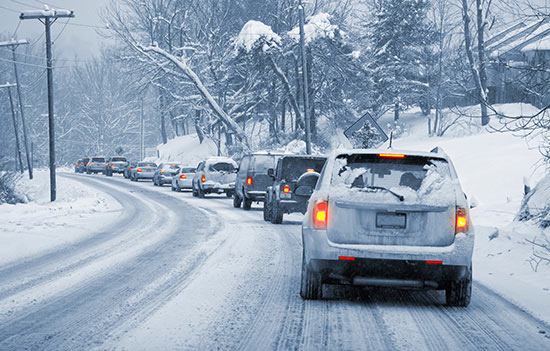Driving in the snow can be very dangerous, even for the most experienced drivers. As you might imagine, driving in snow and ice driving conditions is not the norm for many California drivers. When the time comes – either through the mountains or in Northern California – most are forced into unfamiliar territory.
Every driver should understand the basics of driving through wintry conditions, even if their home region doesn’t experience snow or ice. If you travel during the winter, through the mountains, or up north, you need to be prepared.
So, what should you do to ensure that you can safely maneuver your car on snow-covered roads?
Below are ten pro snow driving tips to help you stay safe on the road this winter.
Table of Contents
1) Allow Extra Time to Get to Your Destination
The first thing to accept when driving on snow-covered roads is that it will simply take longer than usual to get where you’re going. This is important for two reasons.
First, if you get stuck in traffic or an accident happens ahead of you, it’s good to have extra time on your hands. That way, you don’t feel rushed and stressed out – which commonly leads to reckless driving. Second, snow-covered roads require extra caution when driving, so the more time you give yourself to get places safely, the better.
2) Don’t Postpone Vehicle Maintenance
This crucial snow driving tip is to ensure your car is ready for driving in winter conditions as the season approaches. This includes checking your fluids and tire pressure to ensure they are adequate for winter driving.
If the mechanic notices any issues with your car, be sure to address them quickly. The last thing you want is for your vehicle to suddenly break down in the middle of a snowstorm. If the issue reoccurs after multiple repair attempts (and is covered under warranty), you may qualify for California lemon law. Contact a California lemon law attorney to learn more about your options.
3) Completely Defrost Your Windshields Before Driving
When the weather is cold enough for snow, you will almost certainly have to deal with iced-over windshields in the morning. To drive safely in snowy conditions, you must thoroughly defrost all of your windows before getting behind the wheel. This is for your safety and that of the people around you.
This can be done by turning on your defroster and the heater in your car. If necessary, you can also use ice scrapers or de-icer spray to help clear away frost. Just be sure that all of your windows are completely clear before heading out onto the road.
If you can, run your car with the heat blasting for 10-15 minutes before you leave.
4) Drive with Your Lights On
Even if it’s still daylight outside, you should always drive with your lights on in snowy or icy conditions. This snow driving tip is a necessary safety precaution, as it helps other drivers see you more easily.
When driving in the snow, be sure to use your low-beam headlights rather than high beams. This will help you see further down the road while limiting the light that reflects off the snow and back into your eyes. In addition, it’s always a good idea to activate your vehicle’s hazard lights when driving in a severe snowstorm.
5) Use the Right Mode
To drive safely in the snow and avoid accidents, it’s important to know how to use your car’s various modes and systems. For example, many newer cars have a “snow” or “winter mode,” which reduces power output and prevents wheelspin.
Knowing when to activate this mode can make all the difference in snowy conditions.
6) Invest in Winter Tires

High-quality winter tires can make all the difference when driving on snowy roads. Regular tires can lose traction quickly on icy or snowy roads, even when the car is moving slowly. Winter tires have specialized rubber compounds that help them grip the road and maintain stability in cold weather.
So, if you’re planning to drive in snow-covered areas of California, such as a ski resort, be sure to invest in the right tires. Doing so can help ensure you arrive at your destination safely without any issues.
7) Keep a Distance of four Car Lengths
It takes longer for cars to stop or react on snow-covered roads. When driving in the snow, you need to maintain a safe distance between other vehicles – more than you think. The state of California recommends keeping a distance of at least four car lengths.
This will help you avoid collisions, especially in situations where the road suddenly becomes icy or a vehicle ahead of you begins to swerve. Having extra space between your car and the one in front of you can dramatically reduce your chances of getting into an accident.
8) Know When to Use Chains
Some areas of California are known for experiencing heavy snowfall and dangerous driving conditions. In these areas, it’s common to see signs on the side of the road that says, “chains required.” These signs indicate that you must use chains on your tires in order to get through the road ahead.
Just be sure to remove your snow chains as soon as you are able, so that they don’t harm your tires or cause unnecessary wear and tear. These types of damages are not covered by the lemon law in California. Therefore, you would need to pay for them out of pocket.
9) Brake Slowly and Gently
Driving on slippery surfaces like snow or ice can increase your risk of skidding, especially when braking. As such, hitting the brakes hard or abruptly can cause your car to slide and lose traction, which could result in a collision.
Instead, be sure to apply gentle pressure when braking. This will help you slow down slowly and safely rather than locking up your wheels and causing your car to skid.
10) Learn to Control Understeer and Oversteer
A common issue while driving in the snow is understeer and oversteer. Understeer happens when your front wheels lose grip on the road, causing the car to veer off-course. Oversteer is similar, but the rear of your vehicle loses traction first. Either way, you will need to learn how to control these issues to avoid collisions.
One way to prevent understeer and oversteer is to be conscious of your steering input. If you begin to feel the car veering off-course, gently adjust your wheel in the direction it’s going. Fighting against the car’s momentum will only increase your risk of losing control.
The Wrap Up
Driving in the snow can be challenging, but with these tips, you will feel more confident and safe on the roads. Just be sure to use extra caution and always pay close attention to your surroundings. With a bit of practice, you’ll soon master driving in inclement weather!
Author Bio: Brian K. Cline’s Lemon Law Legal Group provides premier legal services. Our California lemon law lawyers aggressively and ethically force vehicle manufacturers to buy back defective and dangerous vehicles. Our team includes experienced trial lawyers with over 40 years of combined trial experience.

